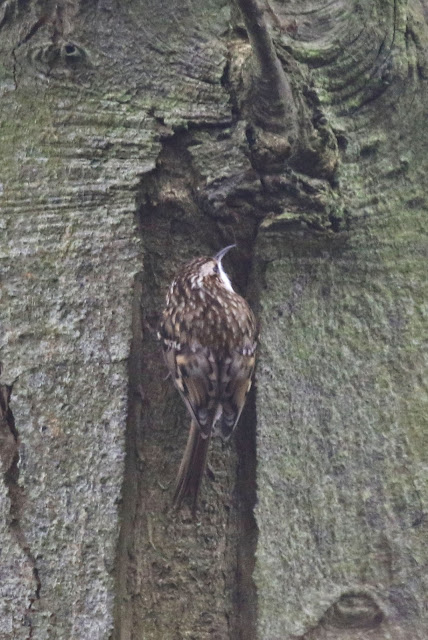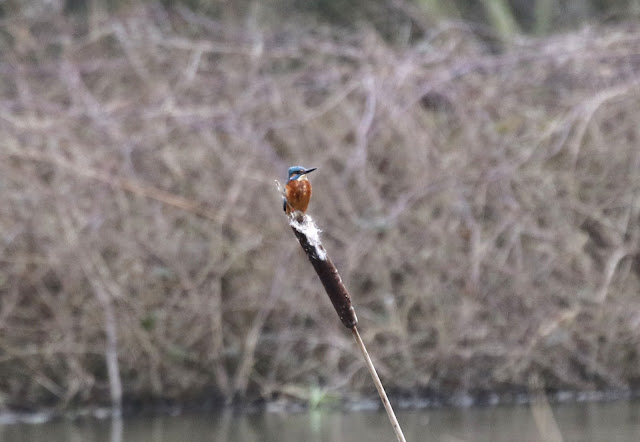The local Little Owl continues to show well in the Stone Creek area.
Little Owl
On Tuesday we were able to stick with Danes' Dyke. There was a perishing wind, but the site itself was relatively well-protected from the wind. We were leaving the car park when a dog walker flushed 6 Roe Deer from the rough grassland outside down the bank and on to the approach road. We walked to the exterior hedge, where we were blessed with a close view of a Yellohammer.
We walked back into the woodland and at the head of some steps we saw a Treecreeper. The Goldcrest, normally at this site, was missing for the first time. We walked through the woodland, which was full of singing Song Thrushes and Chaffinches, but little else. From the cliff top we saw 2 Cormorants on a yellow buoy, but again they were the only sighting. The beach was similarly quiet.
The following day strong winds were forecast, so we switched to Ness End. From the Green Hide we could see a pair of Goldeneye, Tufted Ducks and Gadwall. A pair of Marsh Harriers showed well at times, and appeared to be attempting to reinforce the pair bond by making feint food passes.
Marsh Harriers (c) 2024 Tony Robinson
Cormorants (c) 2024 Tony Robinson
A walk round the edge of the reedbed added a noisy Water Rail and a singing Cetti’s Warbler. There was another pair of Goldeneye from Target Lake, plus Shoveler asleep on the island. There was no sign of any Snipe or Redshank. A pair of Wigeon was on the riverbank. After lunch a Redshank was on the edge of the river.
As we walked past the hotel everyone heard a distant booming Bittern, which became louder as we approached the screen. We also first heard and then saw a pair of dancing Great Crested Grebes. From the screen we could hear both Water Rail and Cetti’s Warbler, and we managed to glimpse the former’s bill in a dark area of the reeds.
On Thursday bad weather had originally been forecast, only for the rain to stop and at first it was windfree. We walked down Dryham Lane first, but the feeders had gone, so we turned in at the first gate. After lunch there was a mobile Chiffchaff singing along Dryham Lane catching insects, but impossible to photograph. There was a very smart Reed Bunting here, and near the dead young elms Paul had a close encounter with a Redwing. There were also Siskins which showed well in this corner. We had a look for GM2’s Peregrine, and sure enough it was in the usual tree, but in a lower branch.
From the impromptu feeding area, we enjoyed great views of Siskins, but the Bramblings were a little more elusive. However, after lunch a male Brambling with the “Greenfinch” disease attempted to feed under some thin branches. A bit of seed brought a pair of Bullfinches, and even another Redwing came for a look. We walked to the farm, but didn’t see anything different here, although on the return journey we had acceptable views of a singing Cetti’s Warbler in a Willow.
On Friday we started as soon as everyone was ready, 20 minutes earlier than usual, to try and beat the coming rain. The group went to the newest hide from which it was possible to see the distant last-remaining female Scaup. As we left the hide we could hear a singing Treecreeper to the west, which we all saw climbing a Larch tree. We then repaired to North Marsh where two photographers were already ensconced. They said that though they had been there for a while, there had been no sign of the Kingfishers. However, their calls were immediately apparent. The female was perched on a horizontal bullrush at the far side of the marsh, whilst the male was calling from another bullrush just over the bank of the River Hull. During our time in the hide they never came any closer.
Kingfisher
We walked north for a while, where we came across a small herd of Roe Deer just after the Oxford pigs. The sky had clouded over, but we managed to return to the car park before the rain really began to pour.
Roe Deer






































































No comments:
Post a Comment